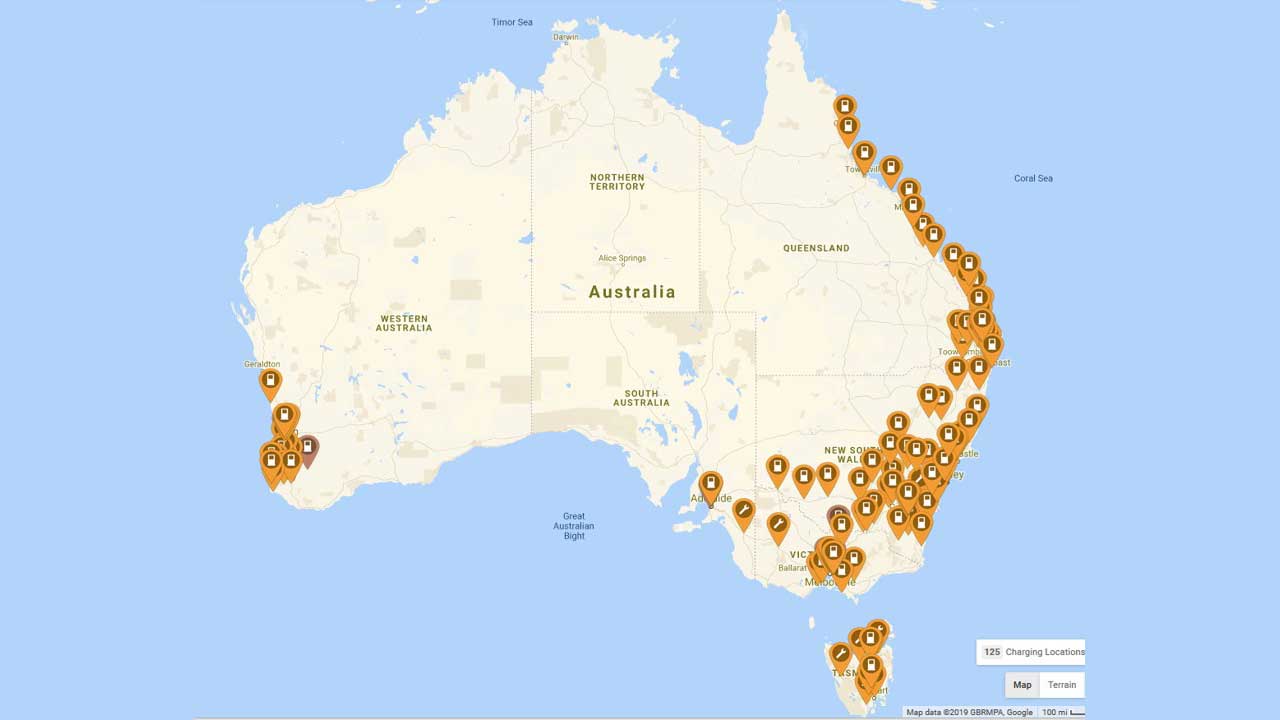Australia may be a laggard in electric vehicle uptake, but at least the number of public fast chargers has more than doubled since 2018.
Installed by a handful of network providers including Chargefox, motorist’s association NRMA, the Queensland government and most recently, Evie Networks, the total number of public DC fast chargers now exceeds 100 locations.
For the most part, owners of electric vehicles (EVs) will charge vehicles at home for everyday driving needs (much like a mobile phone), but access to public chargers to “top up” driving range is crucial for those travelling between cities, going on holidays and for those who live in apartments or terraces.
Charging points provided at EV fast charging sites (that operate on DC as opposed to AC power) allow EVs to charge at a faster rate than at home.
Fast chargers can add 4-50km driving range in a 10 minute charge, while 350kW ultra-rapid chargers – such as those made by Brisbane-based Tritium or Swiss electrical equipment maker ABB – can add up to 350km driving range in just 10 minutes – if the EV can cope with that rate.
Head of sales for Tritium in Australia/NZ Chris Hewitt says the addition of 350kW ultra-rapid chargers to the EV landscape in Australia in 2019 represents a massive shift.
“As the maps of publicly-available chargers show, 2019 has seen a huge increase in available charge points across the country,” said Hewitt told The Driven.
“Perhaps the biggest change this year has been the addition of high-power chargers in Australia; in 2018 there were none. But in 2019, through the likes of Chargefox and Evie Networks, we’ve seen up to 10 sites go live with 350kW of power, which can add 350kms range in 10 minutes of charging.”
“We estimate that 95 per cent of the chargers installed this year were either Veefil-RT 50kW DC Fast Chargers or Veefil-PK 350kW DC High Power Chargers from Tritium.”
There are not yet any electric vehicles available in Australia that can take full advantage of the 350kW chargers – the Porsche Taycan can, and the Tesla Model 3 can theoretically reach up to 250kW depending on variant.
As improvements in battery technology and EV architecture will allow more EVs to charge at that rate.
Sites such as those being rolled out by Chargefox and Evie Networks typically have both fast and ultra-rapid chargers and ensure both main DC plug types – CCS2 and CHAdeMO – are provided.
Chargefox both manages its own sites, which have been made possible by funding from the Australian Renewable Energy Agency (ARENA), Car Sales’ Greg Roebuck, Australian Motoring Services (RACV, NRMA, RACQ, RAC, RAA and RACT) and Wilson Transformers, and also oversees installs for other providers such as NRMA.
In July, it also inked a deal with the Queensland government to take over management of the Queensland Electric Super Highway (QESH) that means once its own 22-strong network is complete, EV owners can use the same network all the way from Adelaide to Cairns.
“We have now well over 1100 plugs on our network, both public and private,” Chargefox CEO Marty Andrews tells The Driven.
“There are 430 on the public network – more than double this time last year. In December last year we had about 175 public chargers,” he says.
Although the uptake of electric vehicles in Australia is still in its infancy, Andrews says that usage of the network is definitely on the increase.
“We have someone plugging in every 7 minutes, and we’ve done a bit of math and we reckon we’ve powered over 1 million carbon free kilometres this year alone,” he says.
In terms of carbon emissions – assuming an average power consumption of 6km/kWh and based on the fact that the Chargefox DC chargers are totally powered by renewable energy, while other plugs on the network rely in grid power – this equates to 187 tonnes saved, says Andrews.
So what is in store for 2020? Along with the rest of the planned Chargefox network and a number of NRMA sites in regional areas of NSW, Evie Networks is just getting started.
In November, it opened its first ultra-rapid charging site at Coochin Creek on Queensland’s Sunshine Coast, and all in all has 50 sites planned, funded by St Baker Energy Innovation Fund to the tune of $35 million a $15 million recoupable grant from ARENA.
The Evie network sites will compliment existing locations managed by other providers, and will also focus on a series of “ring” locations on the edges of cities giving EV owners range confidence when leaving town.
“We will expand our network coverage into NSW, Victoria and Tasmania while further building on our presence in Queensland,” Evie Networks CEO Chris Mills told The Driven.”
“Delivering greater inter-city access for EV drivers around Australia and importantly show casing our commitment to a high standard of customer experience.
“Our sites will feature at least two Tritium ultra-fast chargers, 24/7 access, security, lighting and onsite amenities for Customer while they charge.
“In addition, 2020 will bring new announcements for the next phase of Evie Networks plans to help accelerate the uptake of electric vehicles in Australia,” says Mills.
“Australia’s networks are getting ready for an increase in electric vehicle uptake in 2020 and we expect to see more HPCs come online as Evie and Chargefox continue to rollout their ultra-fast networks across Australia,” says Hewitt.

Bridie Schmidt is associate editor for The Driven, sister site of Renew Economy. She has been writing about electric vehicles since 2018, and has a keen interest in the role that zero-emissions transport has to play in sustainability. She has participated in podcasts such as Download This Show with Marc Fennell and Shirtloads of Science with Karl Kruszelnicki and is co-organiser of the Northern Rivers Electric Vehicle Forum. Bridie also owns a Tesla Model Y and has it available for hire on evee.com.au.





